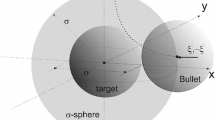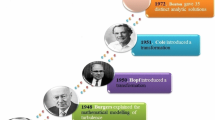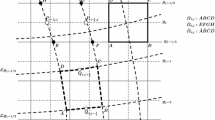Abstract
Describing complex phenomena by means of cellular automata (CAs) has shown to be a very effective approach in pure and applied sciences. Most of the applications, however, rely on multidimensional CAs. For example, lattice gas CAs and lattice Boltzmann methods are widely used to simulate fluid flow and both share features with two-dimensional CAs. One-dimensional CAs, on the other hand, seem to have been neglected for modeling physical phenomena. In the present paper, we demonstrate that some one-dimensional CAs are equivalent to a stable linear finite difference scheme used to solve advection–diffusion partial differential equations (PDEs) by relying on the so-called iota-delta representation. Consequently, this work shows an important link between continuous and discrete models in general, and PDEs and CAs more in particular.






Similar content being viewed by others
References
Wolfram S (2002) A new kind of science. Wolfram Media, Champaign, IL
Wolfram S (1988) Complex systems theory. In: Proceedings of the founding workshops of the Santa Fe Institute, Addison-Wesley, Emerging Syntheses in Science, pp 183–189
Wolfram S (1984) Cellular automata as models of complexity. Nature 311:419–424
Hardy J, Pomeau Y, de Pazzis O (1973) Time evolution of a two- dimensional model system. I. Invariant states and time correlation functions. J Math Phys 14(12):1746–1759
Succi S (2001) The lattice Boltzmann equation, for fluid dynamics and beyond. Oxford Science Publications, Oxford
Frisch U, Hasslacher B, Pomeau Y (1986) Lattice-gas automata for the Navier–Stokes equation. Phys Rev Lett 56(14):1505–1508
Wolfram S (1986) Cellular automaton fluids I: basic theory. J State Phys 43(3/4):471–526
Frisch U, d’Humières D, Hasslacher B, Lallemand P, Pomeau Y, Rivet J-P (1987) Lattice gas hydrodynamics in two and three dimensions. Complex Syst 1:649–707
McNamara G, Zanetti G (1988) Use of the Boltzmann equation to simulate lattice-gas automata. Phys Rev Lett 61:2332–2335
de Ozelim LCSM, de Cavalcante ALB, de Borges LPF (2013) Continuum versus discrete: a physically interpretable general rule for cellular automata by means of modular arithmetic. Complex Syst 22(1):75–99
Wuensche A, Lesser MJ (1992) The global dynamics of cellular automata: an Atlas of basin of attraction fields of one-dimensional cellular automata. Santa Fe Institute Studies in the Sciences of Complexity, Addison-Wesley, Reading, MA p 250
Chua L (2006) A nonlinear dynamics perspective of Wolfram’s new kind of science, vol 1. World Scientific Publishing Company, Singapore
Chua L (2007) A nonlinear dynamics perspective of Wolfram’s new kind of science, vol 2. World Scientific Publishing Company, Singapore
Chua L (2009) A nonlinear dynamics perspective of Wolfram’s new kind of science, vol 3. World Scientific Publishing Company, Singapore
Chua L (2011) A nonlinear dynamics perspective of Wolfram’s new kind of science, vol 4. World Scientific Publishing Company, Singapore
Chua L (2012) A nonlinear dynamics perspective of Wolfram’s new kind of science, vol 5. World Scientific Publishing Company, Singapore
Redeker M, Adamatzky A, Martínez GJ (2013) Expressiveness of elementary cellular automata. Int J Mod Phys C 24(3):1350010. doi:10.1142/S0129183113500101
Omohundro S (1984) Modelling cellular automata with partial differential equations. Physica D 10:128–134
Chopard B, Droz M (1998) Cellular automata modeling of physical systems. Cambridge University Press, Collection Al’ea Saclay
Kunishima W, Nishiyama A, Tanaka H, Tokihiro T (2004) Differential equations for creating complex cellular automaton patterns. J Phys Soc Jpn 73:2033–2036
de Ozelim LCSM, Cavalcante ALB, de Borges LPF (2013) On the iota-delta function: universality in cellular automata’s representation. Complex Syst 21(4):1–12
LeVeque RJ (2007) Finite difference methods for ordinary and partial differential equations. Society for Industrial and Applied Mathematics (SIAM), Philadelphia, PA
Najafi HS, Hajinezhad H (2008) Solving one-dimensional advection–dispersion with reaction using some finite-difference methods. Appl Math Sci 2(53):2611–2618
Datta BN (1995) Numerical linear algebra and aplications. Brooks/Cole Publishing Company, Belmont, CA
Author information
Authors and Affiliations
Corresponding author
Rights and permissions
About this article
Cite this article
Ozelim, L.C.d.S.M., Cavalcante, A.L.B. & Baetens, J.M. On the iota-delta function: a link between cellular automata and partial differential equations for modeling advection–dispersion from a constant source. J Supercomput 73, 700–712 (2017). https://doi.org/10.1007/s11227-016-1795-7
Published:
Issue Date:
DOI: https://doi.org/10.1007/s11227-016-1795-7




